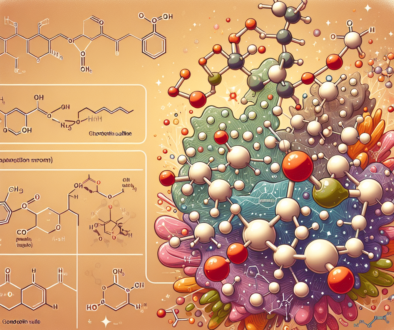Alpha Lipoic Acid Half Life: What to Know
-
Table of Contents
- Alpha Lipoic Acid Half Life: Essential Insights and Implications
- Understanding Alpha Lipoic Acid
- The Pharmacokinetics of Alpha Lipoic Acid
- Alpha Lipoic Acid Half Life: A Closer Look
- Factors Influencing Alpha Lipoic Acid Half Life
- Therapeutic Implications of ALA’s Half Life
- Research and Case Studies on Alpha Lipoic Acid
- Conclusion: Key Takeaways on Alpha Lipoic Acid Half Life
- Discover ETChem’s Protein Products
Alpha Lipoic Acid Half Life: Essential Insights and Implications

Alpha Lipoic Acid (ALA) is a naturally occurring compound that’s vital for cellular energy production and has potent antioxidant properties. It is both water and fat-soluble, which allows it to work in every cell or tissue in the body. The half-life of a substance is a critical pharmacokinetic parameter that indicates how long it takes for half of the drug to be eliminated from the bloodstream. Understanding the half-life of ALA is crucial for determining its dosing frequency and potential efficacy in various therapeutic applications.
Understanding Alpha Lipoic Acid
Before delving into the half-life of ALA, it’s important to understand what this compound is and its role in the body. ALA is involved in mitochondrial dehydrogenase reactions, which means it plays a key role in energy metabolism. Additionally, due to its antioxidant properties, ALA is thought to protect against oxidative stress, which is implicated in a variety of chronic diseases.
The Pharmacokinetics of Alpha Lipoic Acid
The pharmacokinetics of a drug refers to the movement of the drug into, through, and out of the body. The key parameters include absorption, distribution, metabolism, and excretion. ALA’s pharmacokinetics are complex due to its rapid metabolism and distribution in the body.
Alpha Lipoic Acid Half Life: A Closer Look
The half-life of ALA is relatively short, typically ranging from 30 minutes to 1 hour. This means that the concentration of ALA in the blood decreases by half in this time frame. The short half-life of ALA suggests that it is rapidly metabolized and excreted, which can influence dosing schedules for therapeutic use.
- Absorption: ALA is quickly absorbed after oral administration, with peak plasma concentrations typically reached within 30 minutes to 1 hour.
- Distribution: Once absorbed, ALA is rapidly distributed throughout the body and can cross the blood-brain barrier, which is beneficial for neurological conditions.
- Metabolism: ALA is metabolized in the liver, and its metabolites are also thought to have biological activity.
- Excretion: ALA and its metabolites are primarily excreted through the urine.
Factors Influencing Alpha Lipoic Acid Half Life
Several factors can influence the half-life of ALA, including dosage form, route of administration, and individual patient characteristics such as age, liver function, and renal function.
- Dosage Form: The formulation of ALA (e.g., tablets, capsules, or intravenous solutions) can affect its bioavailability and, consequently, its half-life.
- Route of Administration: ALA can be administered orally or intravenously. Intravenous administration bypasses the first-pass metabolism, potentially altering the half-life.
- Individual Characteristics: Variations in liver and kidney function among individuals can lead to differences in the metabolism and excretion of ALA, affecting its half-life.
Therapeutic Implications of ALA’s Half Life
The short half-life of ALA has implications for its use in clinical settings. Frequent dosing may be necessary to maintain therapeutic levels in the body, especially for conditions that require consistent antioxidant support or energy metabolism enhancement.
- Antioxidant Therapy: ALA’s antioxidant properties make it a candidate for treating conditions associated with oxidative stress, such as diabetic neuropathy.
- Metabolic Support: ALA’s role in energy metabolism suggests potential benefits for metabolic disorders.
- Dosing Considerations: To overcome the short half-life, sustained-release formulations of ALA have been developed to maintain therapeutic levels over a longer period.
Research and Case Studies on Alpha Lipoic Acid
Research studies and clinical trials have investigated the effects of ALA on various health conditions, providing insights into its therapeutic potential and the importance of understanding its half-life.
- Diabetic Neuropathy: Several studies have shown that ALA can improve symptoms of diabetic neuropathy, with dosing schedules adjusted to account for its short half-life.
- Weight Loss: Some research suggests that ALA may aid in weight loss, although the results are mixed and more studies are needed.
- Neurodegenerative Diseases: Due to its ability to cross the blood-brain barrier, ALA is being studied for its potential in treating neurodegenerative diseases like Alzheimer’s.
Conclusion: Key Takeaways on Alpha Lipoic Acid Half Life
The half-life of alpha lipoic acid is a critical factor in its pharmacokinetics and therapeutic application. Its rapid metabolism and excretion necessitate careful consideration of dosing frequency to ensure effective levels are maintained in the body. The development of sustained-release formulations and further research into ALA’s benefits will continue to inform its use in various health conditions.
Discover ETChem’s Protein Products
If you’re interested in health supplements and ingredients, consider exploring ETChem’s protein products. ETChem is a reputable manufacturer and supplier known for high-quality collagens and protein supplements that cater to a wide range of industries. Their products are characterized by neutral taste and instant solubility, making them an excellent choice for your protein needs.
About ETChem:
ETChem, a reputable Chinese Collagen factory manufacturer and supplier, is renowned for producing, stocking, exporting, and delivering the highest quality collagens. They include marine collagen, fish collagen, bovine collagen, chicken collagen, type I collagen, type II collagen and type III collagen etc. Their offerings, characterized by a neutral taste, instant solubility attributes, cater to a diverse range of industries. They serve nutraceutical, pharmaceutical, cosmeceutical, veterinary, as well as food and beverage finished product distributors, traders, and manufacturers across Europe, USA, Canada, Australia, Thailand, Japan, Korea, Brazil, and Chile, among others.
ETChem specialization includes exporting and delivering tailor-made collagen powder and finished collagen nutritional supplements. Their extensive product range covers sectors like Food and Beverage, Sports Nutrition, Weight Management, Dietary Supplements, Health and Wellness Products, ensuring comprehensive solutions to meet all your protein needs.
As a trusted company by leading global food and beverage brands and Fortune 500 companies, ETChem reinforces China’s reputation in the global arena. For more information or to sample their products, please contact them and email karen(at)et-chem.com today.




